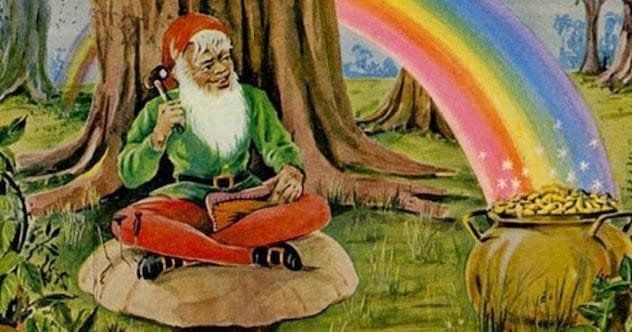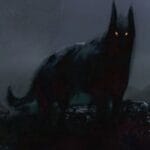“Lay your ear close to the hill. Do you not catch the tiny clamour, Busy click of an elfin hammer, Voice of the Lepracaun singing shrill As he merrily plies his trade?” These enchanting lines from Irish poet William Allingham paint a classic picture of the leprechaun. But there’s so much more to these mischievous figures than meets the eye. Beyond the pot of gold and the shoemaking, leprechauns have a rich history filled with intriguing transformations and surprising characteristics. Ready to dive into the captivating world of Ireland’s most famous fairy? Let’s explore some truly fascinating aspects!
10. Leprechauns: From Water Sprites to Land Dwellers
Believe it or not, the leprechaun legend initially sprang from pre-Christian Irish mythology involving the Tuatha Dé Danann, where they were first envisioned as playful water spirits. An ancient tale from the eighth century, The Saga of Fergus mac Léti, recounts how a king of Ulster was abducted by three tiny water sprites known as “lúchorpáin” while he slept. Awakened by the chilly water, the king managed to capture these little imps and, in exchange for their freedom, demanded three wishes. However, their inherent trickery in granting these wishes ultimately led to his downfall.
Over time, the common image of leprechauns changed. They became known as bearded fairies, about three feet tall, residing in hidden underground caves or the hollows of trees. Their mythology expanded, and they were often depicted in folk tales as diligent cobblers, clad in red (yes, red!) jackets and breeches, with cocked hats. Despite this physical transformation from their water-sprite origins, their penchant for trickery remained a constant. In one well-known Irish folk tale, a farmer named Jack manages to make a leprechaun reveal its gold. Lacking a spade, Jack marks the spot with a stocking. Upon his return, he finds the leprechaun has cleverly placed identical stockings on thousands of dandelions, thwarting the farmer’s greed but delighting his wife with a lifetime supply of stockings.
9. The Curious Case of the Word “Leprechaun”
The etymology of “leprechaun” is as tricky as the creature itself. As mentioned, the earliest reference was to “lúchorpáin,” meaning “little bodies” in Old Irish. Scholars also point to “leithbrágan,” translating to “half shoemaker,” reflecting the common portrayal of leprechauns working on a single shoe. While some linguists consider the one-shoe theory a form of folk etymology (a playful twist on words), they also suggest roots in the Latin word “Lupercalia.” This was an ancient Roman festival known for its revelry, featuring young priests called “Luperci” who ran about naked. Centuries later, a medieval Irish legend emerged where the “Luperci” transformed into supernatural swimmers who survived the Great Flood, haunting Irish waters—bringing us back to the “lúchorpáin,” the water spirits!
And what about the spelling? This article uses the standard American spelling, but leprechauns hail from a land with a rich tapestry of dialects. “Leipreachán” is a common Irish spelling, but you’ll also find “loimreachán,” “lubrican,” “luchramán,” and “lúracán.” He’s called the “logheryman” in northern counties, the “lurigadawne” in County Tipperary, and the “luricawne” in County Kerry. It seems every household in Old Ireland had its own way of spelling these crafty cobblers’ names, perfectly fitting for masters of deception and disguise, even in vocabulary.
8. Not So Charming: The Mean and Ugly Truth
Americans often picture leprechauns as cheerful symbols of good luck, associated with four-leaf clovers, largely thanks to Disney movies, breakfast cereals, and St. Patrick’s Day imagery. However, if we were to assign a more fitting holiday to these little tricksters, it would probably be April Fool’s Day, or perhaps even Friday the 13th!
In traditional Irish folklore, the leprechaun is viewed as a sly, sometimes malevolent elf who delights in tricking people, especially those after his gold. They are masters of pranks and aren’t above hitting the bottle, either with their own brew or by pilfering yours. Be wary of crossing them; they’re adept at casting curses and have been known to sour a household’s milk out of spite. Furthermore, descriptions paint them as untidy in dress and grooming, often carrying an unpleasant odor. They were considered quite ugly, even deformed, with surly manners matching their ragged appearance. Writer D. R. McAnally, in his 1888 compilation of Celtic lore, described the leprechaun as having horrific parentage: an evil spirit father and a degenerate fairy mother. With such a reputation, perhaps their occasional indulgence in drink is understandable.
7. A Boys’ Club: No Female Leprechauns Allowed
Ever noticed that all leprechauns in folklore are male? Indeed, there’s no mention of female leprechauns in the history of Irish tales, which might contribute to their solitary and rather grumpy dispositions. Tiny, drunken cobblers probably wouldn’t fare well in the dating scene anyway. So, how do these little fellows reproduce without female counterparts?
Legend suggests they are either incredibly long-lived or perhaps even immortal, but this doesn’t explain their origins. One theory proposes they hatch from eggs, though who or what lays these eggs remains a mystery. According to Carolyn White’s A History of Irish Fairies, leprechauns are the deformed offspring of fairies; their ugliness and bad temper likely preventing them from finding mates even if she-leprechauns existed. Single-gender supernatural species are common in British Isles folklore. Leprechauns are solitary fairies, typically ill-tempered and reclusive, much like the British hobgoblin and the Scottish brownie, both almost always male. Conversely, the Irish banshee, a wailing messenger of death, is always female. Solitary fairies differ from trooping fairies—the smaller, more conventional winged pixies that come in both genders and are known to smile occasionally, a trait that seems to boost a fairy’s social life.
6. The Pot of Gold: A Lesson in Morality
Most fairy tales and fables conclude with a moral, and leprechaun lore is no exception. Their famed pots of gold at the end of the rainbow, and the greedy humans who seek them, serve as cautionary tales against the deadly sin of greed. The trickery leprechauns employ are examples of poetic justice, reminding us that get-rich-quick schemes rarely end well.
Many of these stories share a common pattern: an ordinary person, often a farmer, stumbles upon a leprechaun busy at his shoemaking. As legend dictates, the elf is either transfixed by the human’s gaze or captured, forced to reveal his gold’s location. Frequently, the leprechaun cleverly diverts the human’s attention or uses trickery to escape. In other versions, the human successfully finds the gold, always buried beneath a specific plant. When the human leaves to fetch a spade, making the leprechaun promise not to move the treasure, he returns to find thousands of identical plants, making it impossible to locate the gold. This serves as a punishment for his greed and arrogance. Another legend warns against inhospitality: leprechauns earn gold by making shoes for other fairies but sometimes peddle their craft to humans when short on cash. Hire one, and you get great shoes; turn one away, and risk a curse on your household, from spoiled milk to a broken leg.
5. The Clurichaun: Leprechaun’s Naughty Night-Time Alter Ego
A lesser-known figure in Irish folklore is the clurichaun—a cantankerous, drunken creature with deplorable manners. Interestingly, he looks, dresses, and hides his gold just like a leprechaun. The key difference is that while leprechauns have some limits to their mischief, clurichauns are often downright malevolent, especially at night! Many folklorists believe the two are regional variations of the same being. The daytime leprechaun embodies hard work and clever trickery, while the nighttime clurichaun parties hard, raiding wine cellars and pranking everyone.
Unlike a leprechaun who curses and leaves, a clurichaun might move into your cellar or attic, wherever the alcohol is stored. Tales often tell of afflicted homeowners trying to escape the beast, only to find it has followed them to their new residence. Clurichauns can be loyal to worthy hosts, guarding their wine, but disloyal servants who sneak sips are haunted and harassed. The fear of capture and losing gold is shared by both, though it seems to happen more with the less acerbic leprechaun. The similar patterns in capture tales lead many to believe they are one and the same. In fact, some linguists consider “clurichaun” a dialectal variation of “leprechaun” in southern Ireland. Thomas Keightley’s 1828 book Fairy Mythology tells of a clurichaun named Little Wildbean who haunts a Quaker’s cellar. After a severe assault on the cook, the Quaker flees, only to find Wildbean hidden in a barrel, forcing him to return home with the persistent imp.
4. The Greening of the Leprechaun: An American Tale
During the mid-19th century, the Irish Potato Blight led to a massive wave of Irish immigration to the United States. St. Patrick’s Day parades, already somewhat present, grew in number and significance as Irish-Americans sought to celebrate their heritage. In this period, Irish-Americans often faced ridicule and prejudice. However, after their participation in the Civil War, perceptions began to shift, and St. Patrick’s Day celebrations became popular across diverse backgrounds. Many traditions brought from Ireland were quickly Americanized, and the leprechaun was a prominent symbol that underwent a significant transformation.
Perhaps the most striking change was in the leprechaun’s demeanor, evolving from an ugly, grouchy fairy into a smiling, dapper little fellow clutching a four-leaf clover for good luck. His traditional tiny red coat, often worn for centuries (sometimes to mock the British), was replaced by a green outfit. Green became synonymous with Irish heritage in the U.S., despite azure blue being Ireland’s traditional symbolic color. And the carrot-orange hair and beard? Folkloric descriptions simply paint leprechauns as ancient, implying gray or white hair. The typical American portrayal offends some of Irish heritage as a purely American creation. While modern depictions are usually well-intentioned, the leprechaun’s heavy drinking and old costume were once derogatory symbols used against the Irish. Ironically, this American version has gained popularity in Ireland itself, partly due to media influence, leading to larger St. Patrick’s Day festivities and a tourism boost.
3. “They’re Magically Delicious!” – Leprechauns in Pop Culture
In 1964, General Mills introduced Lucky Charms breakfast cereal, featuring marshmallow bits and a leprechaun mascot on the box. For over fifty years, Lucky the Leprechaun has been a beloved figure, fending off kids trying to snatch his cereal, ranking alongside other iconic mascots like Tony the Tiger. Despite a decline in cold cereal consumption due to lifestyle changes and dietary concerns, Lucky Charms remains popular, its sales often increasing, thanks in part to its sugary appeal and Lucky’s enduring “charm.”
However, mascots aren’t immune to controversy. The Notre Dame Fighting Irish have featured a leprechaun as their official mascot since 1965. Some now argue that the image of an angry little Irish elf, fists raised, is offensive. A 2021 survey even ranked the leprechaun as the 4th most offensive collegiate sports mascot, a claim the university contests, arguing its historical context differs from other controversial mascots. Similar sentiments have been voiced against the NBA’s Boston Celtics leprechaun mascot, which some perceive as tipsy or goofy. Could political correctness eventually target Lucky the Leprechaun too? While leprechauns have eluded capture for centuries in Ireland, the American PC police might prove a formidable foe.
2. Leprechaun in Hollywood: A Cinematic Curse?
In 1993, Jennifer Aniston made her film debut in Leprechaun, unknowingly launching a franchise that now spans eight movies, the first six starring Warwick Davis as the titular character. While Aniston’s career flourished, the Leprechaun movies are largely considered… well, not masterpieces. The first film received terrible reviews, primarily for its awkward blend of humor and horror. Yet, a sequel followed just a year later, another critical disaster. The sequels only seemed to worsen, with titles like Leprechaun 4 in Space (1996) and Leprechaun in the Hood (2000). A 2014 revamp, Leprechaun: Origins, achieved a zero Tomatometer score on Rotten Tomatoes – yes, a perfect zero!
Despite this, like many B-movies (or perhaps C-movies) in the horror genre, Leprechaun has cultivated a cult following that gathers annually to enjoy the on-screen carnage, particularly around St. Patrick’s Day. This places the series alongside other quirky horror cult classics. Rumor has it that another sequel or revamp is being considered. If it does materialize, it’s a safe bet that a Lucky Charms commercial might earn a better critical reception.
1. The Protected (and Possibly Naked) Leprechauns of Carlingford
The Irish seem to hold the legend of the leprechaun dear. A 2011 survey in Ireland (conducted by a whiskey distillery before a leprechaun hunt, mind you) found that one-third of participants believed in leprechauns, and over half believed they existed in the past. More officially, in 2009, leprechauns were deemed a protected species under the European Habitats Directive, at least in one part of County Lough. This came about after P.J. O’Hare, a pub owner from Carlingford, claimed in 1989 to have found small bones, a tiny green suit, a matching hat, and four gold coins on Slieve Foy mountain after hearing a scream. This “proof” (of an apparently naked and partially de-boned leprechaun) was displayed in his pub for years. After his death and the pub’s sale, the gold coins vanished.
Years later, P.J.’s friend, Kevin “McCoillte” Woods, claimed to have found the coins hidden in a stone wall, subsequently gaining the ability to converse with leprechauns. He asserts there are exactly 236 leprechauns living nearby, the last of their kind, and that P.J.’s findings were intentionally left. McCoillte’s lobbying led to the EU granting protected status to Carlingford’s leprechauns, as their existence couldn’t be disproven. Now, McCoillte sells hunting licenses for an annual ceramic leprechaun hunt, with proceeds aiding local charities, and offers tours of a cavern where leprechauns supposedly live. A veritable pot o’ gold, indeed!
From mystical water beings to commercially recognized icons, the leprechaun has certainly had a fascinating journey through folklore and popular culture. Their story is a rich tapestry of trickery, tradition, and transformation, reminding us that there’s often more to legends than meets the eye.
What’s your favorite leprechaun tale or fact? Share your thoughts in the comments below!










